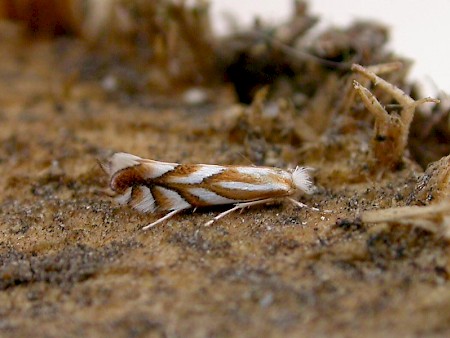15.068 BF346
Scarce Midget Phyllonorycter distentella
(Zeller, 1846)
Wingspan 8-9.5 mm.
A small but striking species. Its range in Britain is almost completely confined to the ancient oak woodlands of Gloucestershire, Monmouthshire and Herefordshire, as well as parts of the Blean Wood complex in Kent. Today, it is considered vulnerable.
The head of the Scarce Midget is crested with a distinctive white tuft. On each forewing, a graceful golden-brown branching pattern extends from base to outer margin. These branches are outwardly trimmed with fine dark borders. Four silvery white bands reach down from the leading edge of the forewing to interlock with the branches. Another two or three of these extend upward from the inner margin. The hindwings are pale grey.
The larvae of this species are leaf miners. Adults lay their eggs on the underside of oak leaves. Hatching in two broods, one July and a second in September and October, the larvae set about boring tunnels into the lower surface of the leaf. The tent-shaped mines they create are large, as far as leaf mines go, averaging 25 mm long. These often travel from the midrib to the leaf’s edge, with the presence of several at a time frequently causing the leaf to warp.
The transformation to moth takes place inside the mine, with the pupae suspended in a fine net of silk. Adults take to the air in May and August.
Description: Michela Sisti

 UKMoths
UKMoths 


